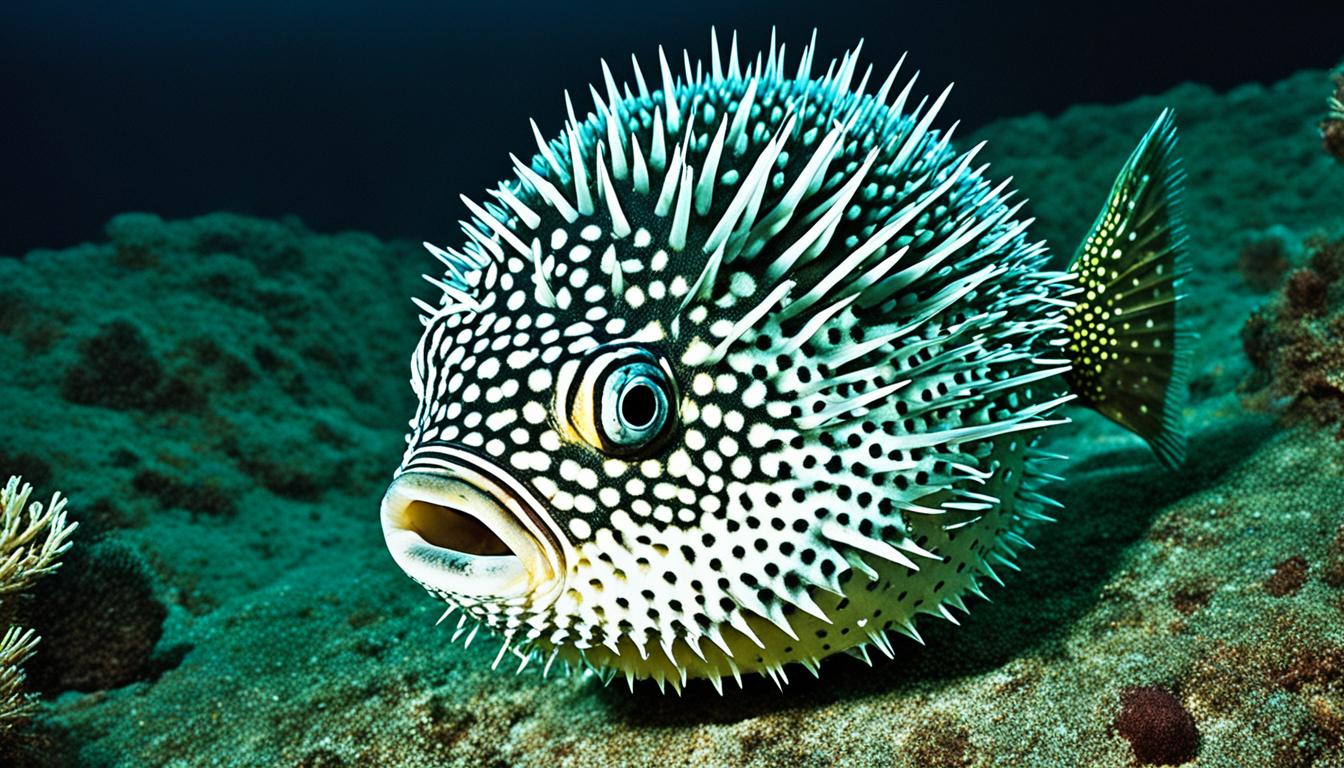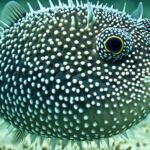Pufferfish, part of the Tetraodontidae family, have many ways to stay safe in the wild. They use special defense strategies that make them hard to catch and show how unique they are in nature. So, how do pufferfish protect themselves? They can swell up big to look bigger and scare off predators. They also make a toxin called tetrodotoxin that keeps predators away. In warm waters, their size and toxin make them both beautiful and a bit dangerous to be around.
Pufferfish Defense Mechanisms
Pufferfish show off amazing pufferfish defense mechanisms that help them survive against many predators. These defenses come from their pufferfish unique features. These have developed over time to protect them in the water where dangers lurk.
Understanding the Pufferfish’s Unique Features
One key pufferfish unique feature is how they swell up when threatened. This makes them bigger and hard to eat. They also have prickly skin that adds to their defense. These features make it tough for predators to get past them, boosting their pufferfish defense mechanisms.
Adaptations for Survival
To make it in the wild, pufferfish have special adaptations for survival. They can’t move fast because their bodies are stiff. But when danger comes close, they fill up with water to get bigger and more intimidating. This skill helps them survive in places where others might not make it.
How do pufferfish defend themselves?
Pufferfish have unique ways to protect themselves from predators. They use inflation and toxins as their main defenses. These strategies help them stay safe.
The Role of Inflation in Defense
When pufferfish feel threatened, they inflate quickly. They fill their stomachs with water, making them up to 100 times bigger. This makes them less appealing to predators.
Their skin also becomes spiny and stiff when they inflate. This makes them look even more intimidating. It stops predators from trying to eat them.
Tetrodotoxin: The Dangerous Chemical
Pufferfish also use a toxin called tetrodotoxin for defense. This toxin is in their skin and organs. It warns predators of the dangers of eating them.
If predators eat pufferfish, they can get very sick or even die. The combination of inflation and toxin makes pufferfish hard to catch and eat.

Pufferfish Protection Strategies
Pufferfish use many ways to stay safe from predators. They have both physical and behavioral tricks to boost their survival odds.
Physical Attributes for Predatory Avoidance
Pufferfish have sharp spines that can lay flat against their bodies. This makes them hard to eat for predators. Some pufferfish also have tough skin that predators find hard to chew on.
Behavioral Techniques to Deter Threats
Pufferfish have smart ways to stay safe. They can puff up quickly when they feel danger. This makes them look bigger and warns predators of their toxins. They also hide in places like rocks and corals, making it hard to see them.
| Protection Strategy | Description |
|---|---|
| Sharp Spines | Flat until threatened, they act as a physical barrier. |
| Abrasive Skin | Hard texture makes consumption difficult for predators. |
| Inflation Response | Increasing size to deter threats and signal toxicity. |
| Environmental Camouflage | Hiding among rocks and corals to avoid detection. |
Pufferfish Survival Tactics in Nature
Pufferfish use many strategies to survive in their environments. They face threats but have unique ways to deal with them. These include how they interact with predators and adapt to their surroundings. These tactics help them survive in the wild.
Interactions with Predators
Pufferfish live in places where big fish and sharks are a big threat. They have a smart way to avoid danger. They can hide by blending in with the sea floor and plants. This makes it hard for predators to find them.
- Camouflage: Helps them evade vision-based hunting.
- Behavioral changes: Alter activities during peak predator feeding times.
- Inflation: Instantly inflates to deter attacks from larger predators.
Environmental Adaptations
Pufferfish also have special ways to adapt to their environment. They change their behavior and what they eat when pollution or overfishing happens. These changes help them survive in tough conditions.
- Diet modification: Shifting to available food sources when primary options decline.
- Habitat assessment: Adjusting to changes in substrate and shelter from threats.
- Social behaviors: Forming schools for added protection in risky environments.
| Survival Tactic | Description |
|---|---|
| Camouflage | Blends into surroundings to avoid predators. |
| Inflation | Expands body to appear larger and unappetizing to predators. |
| Behavioral Adaptations | Modifies activity patterns and social interactions based on predator presence. |
| Dietary Flexibility | Adapts eating habits to exploit available resources. |
| Social Grouping | Schools with other pufferfish for better protection against predation. |
Pufferfish Self-Defense Techniques and Their Effectiveness
The pufferfish has amazing self-defense ways that stand out in the sea. One key method is inflation, where they get much bigger when they feel threatened. This makes them hard to eat and warns other fish to stay away.
They also have a powerful toxin called tetrodotoxin in their bodies. This toxin stops predators from eating them by making them very sick or even deadly. So, pufferfish are not often eaten, which helps them survive in a tough environment.
These fish use both size increase and toxin to defend themselves. This shows how they’ve evolved to stay safe. By doing this, pufferfish help keep the balance in the ocean’s food chain. Learning about their survival tricks gives us a peek into the amazing ocean world.
FAQ
How do pufferfish defend themselves?
Pufferfish use toxicity and inflation to defend against predators. They inflate to be bigger, making them less tempting to threats. They also have tetrodotoxin, a strong toxin that makes them harmful to eat.
What are the unique features of pufferfish that aid in their defense mechanisms?
Pufferfish have short, prickly spines that protect them. They can also inflate a lot, making them bigger. Their stiff skin with spines adds more protection.
How does the inflation mechanism work in pufferfish?
When in danger, pufferfish fill their stomachs with water to swell up. This can make them up to 100 times bigger. It changes their shape and makes them hard for predators to eat.
What role does tetrodotoxin play in pufferfish defense?
Tetrodotoxin is a toxin in pufferfish’s skin and organs. It can cause severe illness or death in predators. This toxin warns predators to stay away.
What protection strategies do pufferfish employ besides inflation?
Pufferfish hide among rocks and corals to blend in. Their sharp spines and rough skin also deter predators. They are alert and can change their behavior to avoid threats.
How do pufferfish adapt to their environment to enhance their survival?
Pufferfish use camouflage to hide from predators. They also change their behavior based on the predators in their area. This helps them survive better.
Are pufferfish’s defense mechanisms effective against all predators?
Inflation and toxicity work well against many predators. But, some big or determined predators can still threaten them. Still, their defense methods usually make them unappealing or risky to predators.







